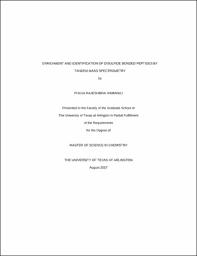
ATTENTION: The works hosted here are being migrated to a new repository that will consolidate resources, improve discoverability, and better show UTA's research impact on the global community. We will update authors as the migration progresses. Please see MavMatrix for more information.
Show simple item record
| dc.contributor.advisor | Chowdhury, Saiful M. | |
| dc.creator | Ramanuj, Pooja Rajeshbhai | |
| dc.date.accessioned | 2019-08-29T18:27:35Z | |
| dc.date.available | 2019-08-29T18:27:35Z | |
| dc.date.created | 2017-08 | |
| dc.date.issued | 2017-08-09 | |
| dc.date.submitted | August 2017 | |
| dc.identifier.uri | http://hdl.handle.net/10106/28638 | |
| dc.description.abstract | Proteins are Comprised of different amino acids which can undergo various modifications known as post-translational modifications (PTMs). Amino acid’s side chains are the most common sites for the PTMs. Cysteine side chain can undergo several PTMs and one very common one is disulfide bond formation. Disulfide bond aids in maintaining protein tertiary structures, its identification is an inevitable aspect in studying protein functions. Furthermore, disulfide bonds are potential targets to develop new protein therapeutics for life-threatening diseases such as cancer. Literature surveys revealed several methods to identify disulfide bonds, which require either high quality sample or are highly laborious. Moreover, unexpected folding patterns in protein structure limits the use of data software in disulfide identification. In this study, a straightforward and novel method was developed for confident identification of cysteine residues involved in disulfide bond formation. In order to develop a robust strategy for mapping disulfide bonds in proteins, we developed a chemical strategy. First, we reduced the disulfide bonds to two -SH and subsequently reacted with a reagent called 2, 3- dibromomaleimide (DBM). The maleimide reacted with sulfhydryl bond of cysteine amino acid and substituted the disulfide bonds. Cysteine sulfur was converted to sulfoxide by mild oxidation to make this bond low energy tandem mass spectrometry cleavable. Due to cleavage, this produced two different
peptides peaks in the mass spectra so disulfide-bonded peptides can be sequenced as linear modified peptides using tandem mass spectrometry. Furthermore, to enrich the disulfide bonds, we added a biotin group in the dibromomaleimide. Biotin is a small molecule, which has strong interaction with a protein avidin. After reduction of disulfide bonds in peptides, we used a similar dibromomaleimide reagent with a biotin group incorporated in it. After that peptide were enriched using avidin immobilized agarose or magnetic beads. After washing the non-binders, the disulfide-bonded peptide was eluted from the beads and peptide sequence was analyzed using liquid chromatography and tandem mass spectrometry. We tested our approach with standard disulfide containing peptides, somatostatin and a protein lysozyme. Efficient labeling was observed in standard peptides and we have identified several disulfide bond scrambling in lysozyme.
In comparison to conventional approaches, our method has three major advantages: (I) reduced sample complexity (II) precise mapping of disulfide bonds (III) faster and easy MS data analysis. Although, there are certain challenges involving oxidation study using biotin dibromomaleimide (BDBM), this method highly enhances the confidence identification of disulfide bonds. We believe this strategy could be an efficient way to enrich and analyze disulfide bonds in proteins. | |
| dc.format.mimetype | application/pdf | |
| dc.language.iso | en_US | |
| dc.subject | Post-transnational modifications | |
| dc.subject | Disulfide identification | |
| dc.subject | Mass spectrometry | |
| dc.title | ENRICHMENT AND IDENTIFICATION OF DISULFIDE BONDED PEPTIDES BY TANDEM MASS SPECTROMETRY | |
| dc.type | Thesis | |
| dc.degree.department | Chemistry and Biochemistry | |
| dc.degree.name | Master of Science in Chemistry | |
| dc.date.updated | 2019-08-29T18:29:46Z | |
| thesis.degree.department | Chemistry and Biochemistry | |
| thesis.degree.grantor | The University of Texas at Arlington | |
| thesis.degree.level | Masters | |
| thesis.degree.name | Master of Science in Chemistry | |
| dc.type.material | text | |
| dc.creator.orcid | 0000-0002-3327-4097 | |
Files in this item
- Name:
- RAMANUJ-THESIS-2017.pdf
- Size:
- 2.435Mb
- Format:
- PDF
This item appears in the following Collection(s)
Show simple item record


